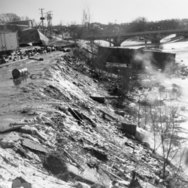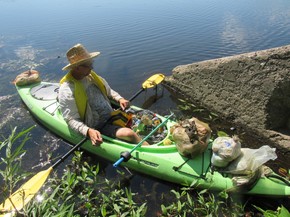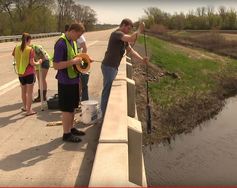
The Minnesota Pollution
Control Agency (MPCA) can trace its roots to the Water Pollution Control Commission,
established by the Minnesota Legislature in 1945 to stop the dumping of raw
sewage into lakes and rivers. Then in 1962 the state suffered two catastrophic
spills: a pipeline break that sent 1 million gallons of oil into the
Mississippi River and a tank rupture that sent 3 million gallons of soy oil
into the Minnesota River. Those spills and other environmental threats led the
Legislature to replace the commission with the MPCA in 1967. Today the agency
continues to work to protect water resources from
pollution, prevent and manage
spills that impact the environment, and much more to protect and
improve human and environmental health.
The first national Earth Day was held
in 1970, a movement started by Republicans and Democrats working together that
led to the Clean Air, Clean
Water, and Endangered
Species Acts.
Earth Day has continued on April 22 each year. But as many
Minnesotans realize, each day needs to be Earth Day. Here are a few ideas for
doing that:
- Volunteer to be a Citizen Stream or Lake Monitor. See the full story below. Local partners like watershed groups and SWCDs can support the program by running the press release in their newsletters and/or on their websites.
- Put water quality data to use. The MPCA and local partners have completed intensive water monitoring of all 80 major watersheds in the states. This monitoring has resulted in a wealth of data for gauging the health of waters and developing strategies to restore or protect them.
- Reduce use of plastics. The Earth Day Network this year is focused on reducing plastic waste because of its impact to water resources. See more information below.
- Advocate. With deep cuts proposed to the U.S. Environmental Protection Agency and state water protection proposals under fire, it’s important for Minnesotans to advocate for their lakes, streams, wetlands and groundwater.
- Take pride in your work. No matter if you’re a volunteer who picks up trash or a watershed professional crunching data, your work makes a difference to Minnesota’s water resources. One way to see that difference: 65% of the state’s lakes and streams are holding their own as far as water clarity
and 25% are improving, according to the MPCA
dashboard of performance measures.
Photo above: Spilled soybean oil
drenches the banks of the Minnesota River after a tank ruptured in January 1963.
The 3 million gallons of oil wreaked havoc on water quality and wildlife as it
flowed downstream toward the Mississippi River. At the time, there was no regulation of tank
construction or requirements for reporting or cleanup of spills.
|
As the snow melts and watershed professionals’ thoughts turn
toward construction, the Clean Water Partnership (CWP) Loan program is
continuously accepting loan applications for nonpoint source pollution
implementation projects. These 0% interest loans are flexible and can help fill
funding needs, such as matching other federal or state grants. The entire
implementation period and repayment period is completely interest free. Borrow
now, implement the project for three years, and pay the loan back over 10
years. Funds can be available in as little as 60 days, just about the time the
snow should be gone this year!
Eligible projects include:
- Urban green infrastructure such as rain gardens, green roofs, and rainwater reuse
- Buffers
- Septic system upgrades and replacements
- Technical assistance
- Equipment such as street sweepers and conservation tillage equipment
- Feedlot upgrades or replacements
- Any Best Management Practices (BMPs)to address nonpoint
source pollution
Local government units can use these funds to implement the
work or loan the funds to a resident to implement the projects.
This is great opportunity to fund projects that may not be
the best fit for grant applications, such as addressing inflow and infiltration
issues or upgrading and replacing septic systems.
Any local government
unit with revenue-generating capability is eligible to apply or they can
sponsor a loan for another entity, such as a soil and water conservation
district, to complete the project. The process is quick and easy. For more information
contact Cindy Penny at 651-757-2099 or cynthia.penny@state.mn.us. Or visit the MPCA website at www.pca.state.mn.us/cwp-loans.

Proposals for funding 2019-20 projects are due May 31 at 4 p.m.
to the Lessard-Sams Outdoor Heritage Council. The
council expects about $100 million to be available for projects that protect,
restore and enhance wetlands, prairies, forests, and habitat. See the full request for proposals on the council
website for details.
The
council makes annual recommendations to the Minnesota Legislature on
appropriations from the Outdoor Heritage Council, which is funded by the Clean
Water, Land and Legacy Amendment.
|

Once the weather warms up, hundreds of volunteers across
Minnesota will head out to their lake or stream to measure its clarity. By
collecting data for the Minnesota Pollution Control Agency (MPCA), these
volunteers provide valuable information for protecting or restoring their
waters.
The agency uses the data to help determine if lakes and
streams are meeting water quality standards designed to protect aquatic life
and recreation like fish and swimming. If so, these waters are candidates for
protective strategies. If not, then studies may follow to determine the
pollutants, sources of those pollutants, and ways to reduce them.
Through the Citizen Monitoring Program, volunteers do a
simple water clarity test in their favorite body of water twice a month during
the summer. Lake monitors boat or paddle to a designated spot to check the
clarity, while stream monitors may walk, bike or drive to the water or a bridge
over it.
More than 1,300 citizen monitors gather data for the MPCA,
but more are needed to reach the 69,000 miles of rivers and more than 12,000
lakes in the state. The MPCA provides equipment and training, and no experience
is needed. For some waters, citizen data is the only data available.
Many volunteers go beyond collecting data:
- In Hennepin County in the Twin Cities area, Sean Connaughty (photo above) coordinates an annual cleanup of Lake Hiawatha. Over the past three years, he and others have logged 879 hours of volunteer time removing 4,500 pounds of trash from the lake.
- For Lake Washington in Le Sueur County in southern Minnesota, Pam Olson initiated a project in an upstream wetland to slow the movement of water during rain events and let sediments settle out before the water flows into the lake.
- In Anoka County in the Twin Cities area, Wayne LeBlanc helped establish a no-wake zone surrounding a shallow sensitive area on Peltier Lake.
- Richard Heimkes in Polk County in
west-central Minnesota has long advocated for Gilchrist Lake and other waters
in Minnesota through work with land management boards.
To join this volunteer effort, use the MPCA’s interactive
map to find out if your favorite lake or stream needs monitoring: www.pca.state.mn.us/water/find-site-and-sign.
To learn more and sign up, visit the Citizen Water Monitoring Program webpage
at www.pca.state.mn.us/water/citizen-water-monitoring,
or call 651-296-6300 (Twin Cities) or 1-800-657-3864 (Greater Minnesota).
|

Based on two new studies available for public review and
comment, the MPCA and local watershed partners are recommending that landowners
implement voluntary management practices to reduce water pollution in the Bois
de Sioux River Watershed in northwest Minnesota. Members of the public may comment on the studies
through May 2.
Land alterations that promote soil drainage, such as
stream channelization and ditching, have led to water pollution, according to
the studies. These activities also
impair stream habitat, water quality, and fish and aquatic insect communities.
In addition to harming fish and other aquatic life, the studies found that
excess nutrients, bacteria, eroded soil, and low dissolved oxygen reduce
recreational opportunities for people in the watershed.
The majority of land in the Bois de Sioux River Watershed
is privately owned. To significantly improve water quality, the MPCA and its
partners recommend that landowners make voluntary changes to their agricultural
practices. In addition, the agency and its partners recommend that Minnesotans
take steps to improve public understanding and interest in these conditions.
The draft Bois de Sioux Total Maximum Daily Load (TMDL) and Watershed Restoration and Protection Strategy (WRAPS) reports also recommend actions that can correct existing
problems and prevent new ones. These actions include creating water impoundments
to prevent flooding, taking highly-erodible areas out of production, and adding
to buffers, cover crops and perennial vegetation.
The TMDL study quantifies the pollutant levels,
identifies pollution sources, and proposes ways to return water quality to an
acceptable level. The WRAPS report identifies impaired water bodies and those
in need of protection, and identifies actions needed to achieve and maintain
water quality.
Comments on the draft reports should be sent to Cary
Hernandez, 714 Lake Avenue, Suite 220, Detroit Lakes, Minnesota 56501 or cary.hernandez@state.mn.us. He is available for more information at 218-846-8124.
Comments must be received by 4:30 p.m. on May 2. More information is available
also from Michelle Swanson, Bois de Sioux River Watershed District
administrator, 320-563-4185, or bdswd@frontiernet.net.
Written comments must include a statement of your
interest in the Bois de Sioux watershed study and/or report, a statement of the
action you wish the MPCA to take, including specific references to sections of
the draft study and/or report you believe should be changed, and specific
reasons for your position.
Photo above: As part of the River Watch program,
volunteers monitor the water quality in the Bois de Sioux watershed.
|
Plastics are poisoning and injuring marine life, littering
beaches and landscapes, and clogging waste streams and landfills, according to the
Earth Day Network. The non-profit group is dedicating Earth Day 2018 to
reducing plastic waste.
As part of Earth Day 2018, the
network has released an online Plastics Pollution Calculator for consumers to calculate the amount of disposable
plastic they use in a year and make plans to reduce the waste.
On its website, the Earth Day Network says 9.1 billion
U.S. tons of virgin (non-recycled) plastic has been produced to date,
generating 6.9 billion U.S. tons of plastic waste, and only 9% has been
recycled.
“Plastic pollution is now an ever-present challenge.
We can see plastics floating in our rivers, ocean, and lagoons, littering our
landscapes and affecting our health and, the future of billions of children and
youth. We have all contributed to this problem – mostly unknowingly – and we
must work to reduce and ultimately to end plastic pollution,’” says Valeria
Merino, vice-president of Global Earth Day at Earth Day Network.
To reduce the impact of plastics:
- Ask yourself every time that you are considering buying a disposable plastic item: Do I absolutely need this? Can I use something else that I already have? Could I buy something that I can use long-term instead?
- Prevent the creation of micro-plastics by properly disposing of plastic products and being careful not to toss plastic products near waterways, beaches or in open spaces.
- Pick up plastic trash whenever you see it, especially in ponds, streams, rivers, and beaches.
-
Look up products on the internet and choose not to buy products containing microbeads. Choose products that have natural exfoliators instead.
-
Consider changing the way you wash your clothing to reduce the number of microfibers that are
released, wash synthetic clothes less frequently, purchasing items made of
natural fibers when possible.

Buffer strips are the top water-quality
improvement strategy in the South
Fork Crow River Watershed, according to draft MPCA reports. The
agency and local partners are seeking public comments on the draft reports through
May 16.
The TMDL
report identifies 42 stream segments failing to meet water quality
standards due to low dissolved oxygen, high phosphorus levels, and altered
hydrology. The report also shows that field drainage and tile drainage to
waterways, especially Buffalo Creek and the South Fork Crow River, are
important factors in stream impairments.
The WRAPS
report identifies areas along Silver Creek and the South Fork Crow River,
upstream of Hutchinson, where healthy buffer strips are helping to improve
water quality. Other suggested strategies include increasing water storage,
proper culvert and bridge sizing, adding riparian buffers with deep roots, and
restoring connectivity and natural stream channels.
The South Fork Crow River watershed is
located in south-central Minnesota and encompasses parts of Kandiyohi,
Renville, Meeker, McLeod, Sibley, Wright, Carver, and Hennepin counties. The
South Fork Crow River joins with the North Fork Crow at Rockford and then joins
the Mississippi River near Dayton.
The MPCA encourages those interested in the
South Fork Crow River Watershed to review and provide feedback on the reports.
Comments may be submitted to Scott Lucas, MPCA, 7678 College Road, Baxter, MN,
56425, or by email to, scott.lucas@state.mn.us by 4:30 p.m. on May 16. For more information, contact Lucas
at 218-316-3874, or toll-free at 800-657-3864.
Written comments must indicate whether they
pertain to the South Fork Crow River watershed’s TMDL or WRAPS report. They
should clearly state the action you wish the MPCA to take, including references
to sections of the report that you believe should be changed; please provide
specific reasons supporting your position.
|
Two programs that that recently won Environmental
Initiative Awards, an annual recognition program for achievements in the
environmental community, show how farmers can make a positive difference to
water quality.
The first winner is the Root River Field to Stream
Partnership, a
water monitoring project in southeast Minnesota that combines data collection,
strong personal relationships, and conservation action. Administered by the
Minnesota Department of Agriculture, this project conducted intensive surface
and groundwater monitoring in order to determine the effectiveness of
agricultural conservation practices. By working closely with water conservation
districts and farmers, a total of 90 grass waterways spanning more than 65,000
feet have been installed in high priority areas. Thirteen new water and
sediment control basins and catchment ponds were also installed, and nearly 200
acres of cover crops have been planted— among other outcomes. These results
were achieved through close and careful coordination with local farmers.
The second winner is the Land O’Lakes SUSTAIN program that
focuses on driving on-farm improvements, protecting
natural resources and helping to ensure the health and productivity of every
acre for every farmer. To do this, Land O’Lakes works with farmers and ag
realtors to identify customized approaches best suited for each farm.
Agriculture retailers, long- trusted advisors to farmers, are trained by
SUSTAIN staff in specialized practices, products and cutting-edge technology
that provide holistic farm insights and advance system-wide on-farm
conservation. Also part of the project, Land O’Lakes SUSTAIN assists farmers
with becoming certified in the Minnesota
Agricultural Water Quality Certification Program by engaging and educating
farmers on benefits, acting as advisers in grant processes, and harnessing
existing data collection capabilities. The joining of regulatory bodies,
private sector interests, and farmer perspectives to create jointly implemented
stewardship solutions is groundbreaking.
The MPCA has extended the public comment period until June 18 for two draft MPCA
documents related to Duluth’s Urban Streams Watershed. The reports focus on
human-related activities — and possible remedies — for impairments in 11 of 16
state-designated trout streams. The documents are the Total Maximum Daily Loads (TMDL) study and the
Watershed Restoration and Protection Strategies (WRAPS)
report. They are companion documents that quantify pollutant levels,
identify pollution sources, and propose ways to return water quality to an
acceptable level.
The
watershed’s problems are related to a highly-developed environment that
includes impermeable roofs, paved streets, and parking lots. As a result, the
collective runoff generates water temperatures too warm for cold-water fish,
bacteria, sediment, stormwater and road salt. Other streams’ fates include
passage through concrete culverts, human-made ditches, or being buried
underground.
Some have
more favorable conditions. Most Duluth-area trout streams start out in natural,
nearly flat wetland areas before rapidly descending rocky cliffs into the St.
Louis River and Lake Superior. Several manage remarkably well and still support
native populations of fish species.
The two Duluth Urban Area Streams Watershed draft reports are
available on the MPCA’s Duluth Urban Area Streams Watershed webpage or
at MPCA’s Duluth office, 525 Lake Avenue South, Suite 400. Written comments
should be submitted by June 18, 2018 to Brian Fredrickson, MPCA, 525 Lake
Avenue South, Suite 400, Duluth, MN 55802, or by email to brian.fredrickson@state.mn.us.
No comments will be accepted by telephone. However, if you need further
assistance or clarification, contact Fredrickson at 218-302-6604.
- April 20-22: Earth Day Festival, Northfield.
- April 21: EarthFest
Expo, Rochester Community and Technical College Field House, 10
a.m.-5 p.m. Keynote speaker at 12:30 p.m.: Amy Skoczlas Cole, of Minnesota
Public Radio, on “Water. Simple. Almost free.” Be sure to stop at the MPCA
booth!
- April 21: CURE annual meeting, 10 a.m., Maynard community center.
-
April 21: Earth Day festival, Prairie Woods Environmental Learning Center, Spicer.
- April 22: Wild and Scenic Film Festival at Sheldon’s Theater in Red Wing, 2 p.m., hosted by the Red Wing Environmental Learning Center.
-
April 26: Watershed Professionals Network, 9:30 a.m., Mankato Pizza Ranch.
- May 2: Minnesota Water Action Day, 8 a.m.-4 p.m., Minnesota State Capitol and Christ Lutheran Church, St. Paul.
-
May 5: Great River Greening Gala, InterContinental Hotel, St. Paul.
- May 10: The Cannon River Watershed Partnership Annual Meeting in Northfield.
- May 17: 10th Minnesota River Congress, Kato Ballroom, Mankato.
- May 23: Environmental
Initiative Awards celebration, 5-9 p.m., Nicollet Island Pavilion,
Minneapolis.
|